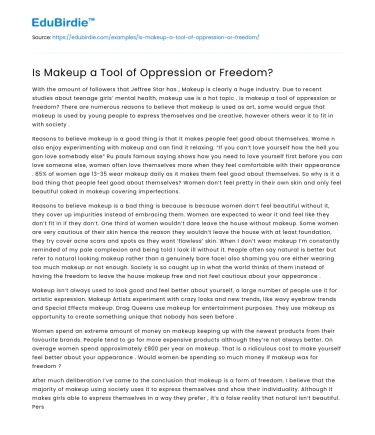Introduction
The discourse surrounding makeup oscillates between its perception as a tool of oppression and an instrument of empowerment. Historically, makeup has been intertwined with notions of femininity, aesthetics, and societal expectations, often placing women at the intersection of cultural norms and personal expression. In contemporary society, makeup usage has evolved, becoming a canvas for self-expression and identity for many. This essay delves into the duality of makeup as both a symbol of subjugation and a means of liberation. By examining historical contexts, modern-day implications, and feminist perspectives, this essay aims to unravel the complexities of this debate, offering a nuanced understanding of makeup's role in society.
Makeup as a Tool of Oppression
Historically, makeup has often been perceived as a tool of oppression, reflecting a patriarchal society's imposition of beauty standards on women. In the 19th century, the rise of consumer capitalism and the burgeoning beauty industry cemented the notion that a woman's worth was intrinsically linked to her appearance. Naomi Wolf, in her seminal book "The Beauty Myth," argues that the beauty industry perpetuates an unattainable standard of beauty, compelling women to conform to unrealistic ideals and thus maintaining their subjugation. The commercialization of beauty products has often exploited insecurities, urging women to invest time, money, and effort to achieve societal approval.
Save your time!
We can take care of your essay
- Proper editing and formatting
- Free revision, title page, and bibliography
- Flexible prices and money-back guarantee
Furthermore, the expectation for women to wear makeup in professional settings reflects entrenched gender biases. Research by Dellinger and Williams (1997) highlights that women who wear makeup are often perceived as more competent and likable in the workplace, pressuring women to conform to specific beauty norms to succeed professionally. This societal expectation reinforces the notion that a woman's natural appearance is inadequate, thus perpetuating societal control over women's bodies and choices. Therefore, from a historical and sociocultural perspective, makeup can be construed as a mechanism that reinforces gender hierarchies and societal control.
Makeup as a Medium of Empowerment
Conversely, makeup has been embraced as a tool of empowerment, offering individuals the opportunity to assert their identity and exercise autonomy. In recent years, the beauty industry has witnessed a transformation, driven by the rise of social media and the democratization of beauty standards. Platforms like Instagram and YouTube have allowed individuals to showcase diverse makeup styles, challenging traditional norms and celebrating individuality. Makeup is no longer confined to gender binaries; instead, it has become a medium for artistic expression and self-identity, as exemplified by the success of makeup artists like James Charles and NikkieTutorials, who advocate for inclusivity and authenticity.
Moreover, makeup can serve as a form of self-care and confidence-building, allowing individuals to feel empowered and in control of their appearance. According to a study by Korichi et al. (2008), many women use makeup to enhance their sense of self-esteem and to express creativity. This perspective aligns with third-wave feminist ideologies that advocate for personal choice and the reclamation of femininity on one's own terms. As such, makeup can be viewed as a powerful tool for self-expression, challenging societal norms and offering a sense of liberation and autonomy to those who choose to engage with it.
Balancing the Dual Perspectives
The debate over whether makeup is oppressive or liberating is further complicated by the intersectionality of race, culture, and class. For instance, the cultural significance of makeup varies across different societies, where it can be a symbol of heritage and identity. In some cultures, traditional makeup practices are integral to cultural rituals and expressions of pride. However, the global beauty industry often appropriates these cultural elements, commodifying them and stripping them of their original significance, as noted by scholars like Minh-Ha T. Pham (2015). This appropriation can perpetuate cultural oppression while simultaneously offering individuals from marginalized communities a platform to reclaim and celebrate their cultural identity.
The multifaceted nature of makeup necessitates a balanced understanding that recognizes both its potential for empowerment and its capacity for perpetuating oppressive structures. Addressing the counterarguments—such as the notion that makeup reinforces traditional gender roles—strengthens the thesis that makeup's role is not monolithic. Rather, its significance is heavily contingent upon individual experiences, societal context, and cultural background. By embracing a nuanced perspective, society can move toward a more inclusive understanding of beauty and identity, one that respects personal choice while acknowledging the historical and cultural dimensions of makeup.
Conclusion
In conclusion, the dual role of makeup as both a tool of oppression and a medium for freedom underscores the complexity of its place in society. While it has historically been used to perpetuate gender norms and societal control, it has also evolved into a powerful form of self-expression and empowerment. The ongoing discourse around makeup reflects broader societal tensions between conformity and individuality, tradition and progress. By understanding the historical, sociocultural, and intersectional factors at play, we can appreciate the multifaceted nature of makeup and its impact on identity and agency. Ultimately, the significance of makeup lies in the personal and collective narratives of those who choose to engage with it, offering a testament to the evolving landscape of beauty and empowerment.






 Stuck on your essay?
Stuck on your essay?

